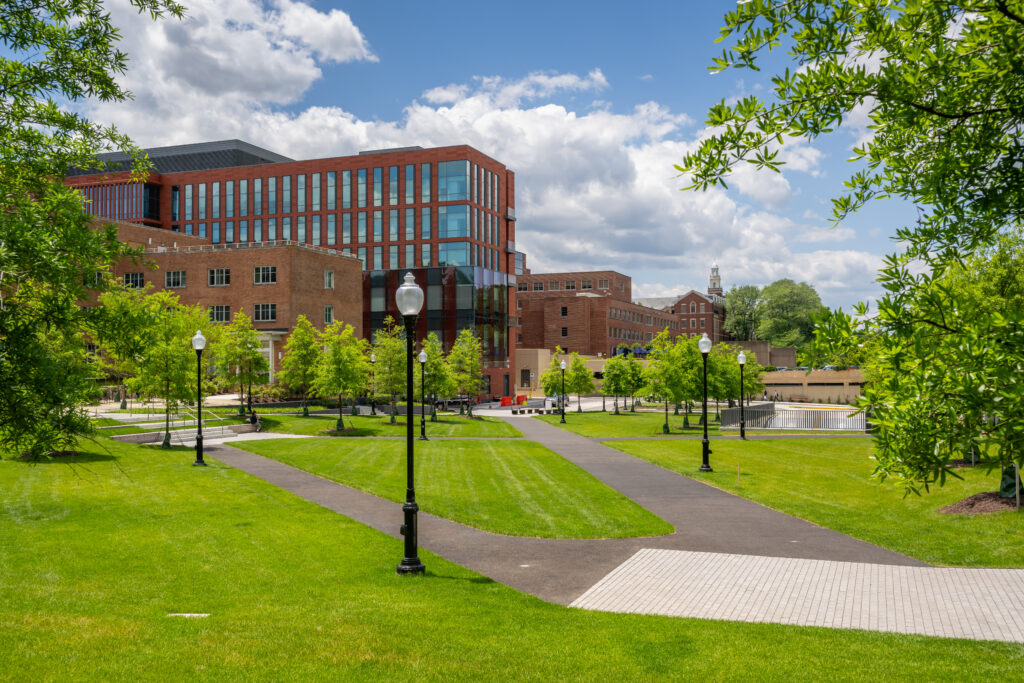Washington, D.C., August 14, 2024 – Seven years ago, if someone walked by the back entrance of Georgetown University, they would have seen a dining hall to the left and a sprawling asphalt parking lot to the right.
Today, on five and a half acres of green space — a treasured commodity on Georgetown’s tightly packed urban campus — they might see students picnicking, dogs running and Frisbees flying in front of the Verstandig Pavilion, MedStar Georgetown’s new 477,000-square-foot hospital, which officially opened on Nov. 30 last year.
“It was really important from the aesthetic perspective that we create a very warm and welcoming northern entrance to the campus,” said Dr. Lisa Boyle, president of MedStar Georgetown University Hospital and senior vice president of MedStar Health, interviewed by The Georgetowner.
The Verstandig Pavilion houses top-notch facilities — 156 private patient rooms, 31 operating rooms, 32 emergency exam rooms and a rooftop helipad — and state-of-the-art technology. It is named for entrepreneur Grant Verstandig, who donated $50 million to MedStar Georgetown in 2021, among the largest philanthropic gifts to health care in the District to date.
Though construction began in 2017, the extensive design process began three years prior. Incorporating different perspectives in the process was key for Boyle, who joked: “I said to myself early on, I will not be that person who does this whole project, and you bring this thing online, and everybody walks in and says, ‘Well, what idiot designed this?’”
To promote transparency and community engagement, MedStar Georgetown also consulted the Georgetown Community Partnership, a collaboration of Georgetown University, MedStar and residents from the surrounding neighborhoods of Foxhall, Burleith and Georgetown.
“I just want to take the opportunity to express extraordinary gratitude to our local community and specific members who really were incredibly valuable in providing the voice of the community, because they are not only potential patients but they are our neighbors, right? So we want to be good neighbors,” Boyle said.
All that collaboration and thoughtfulness paid off in spades. Rejuvenating natural light streams through the building’s 999 windows and each patient room is completely private, outfitted with a futon couch on which loved ones can rest while visiting.
Another element was that MedStar Georgetown offers clinical opportunities for undergraduate and graduate students in the Schools of Medicine and Nursing. According to Boyle, one of the design goals for the new pavilion was facilitating interdisciplinary collaboration among these students, resulting in team meeting spaces and computer rooms, along with a newly built lounge and study area in the main hospital.
“They have all kinds of collaborative spaces, so it really is an enhanced learning environment,” she said.
In terms of recruiting patients and doctors, one of the new pavilion’s greatest strengths is its technological prowess. “We wanted to design and build state-of-the-art operating rooms that offered cutting-edge technology. And that advantages obviously to our patients, but also our team members, to include our students,” Boyle said.
An integration system in the operating rooms features inline cameras that stream into auditoriums in the medical facility, allowing students to watch surgeries live with high-resolution imaging, even for laparoscopic procedures.
“From a learning and education perspective, that technology, that integration, to be able to integrate all types of inputs, is just transformational, and our teams really love it,” Boyle added.
Another technology transforming patient care is MedStar Georgetown’s Intraoperative MRI System, the only machine of its kind in the region. In most cases, patients must be moved to an MRI machine, but the IMRIS moves to the patient during delicate neurosurgeries. This makes it a destination service for patients with brain tumors and movement disorders.
Boyle acknowledged that, for every day patient in the D.C. area, there are a plethora of hospitals to choose from. The metro region is home to seven general hospitals, plus specialized options for groups such as children, veterans and psychiatric patients.
According to surveys, the most common reason D.C.-area patients did not choose MedStar Georgetown was transportation difficulty. The neighborhood lacks a Metro stop and the newly adopted Better Bus Network will reduce service. Ways to make MedStar Georgetown more accessible, including ambulatory care sites for nonemergent patients in other locations, are being actively explored, according to Boyle.
“They have choices, and so we want them to choose us,” she said.
Noting that, over the last 25 years, Georgetown University Hospital has grown from a small community hospital into a destination medical center, Boyle said the Verstandig Pavilion exemplifies that transition.
“We really do take care of some of the sickest patients with some of the most complex clinical problems. And you know, I’m just extremely proud of the fact that we’re able to do so in such an incredible manner,” she said. “I feel like we now have a facility that essentially matches or is equivalent to the high level of complex care that we’ve always delivered.”

